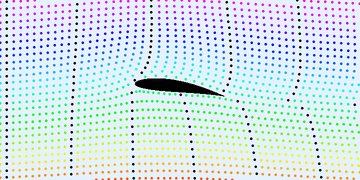Lift
We really cannot cover UAV design foundational basics without talking about lift. We do not need to do an in-depth treatment of lift here, but we will go over some high-level concepts at least for you to keep in mind.
Lift at it's core is simply a perpendicular (typically upward) force exerted on an airfoil as opposed to drag which is a parallel force.
 Source:NASA
Source:NASA
But why does moving an airfoil create lift? If you were to ask NASA, they would tell you there are multiple INCORRECT theories on why lift occurs when an airfoil moves through air.
- "Longer Path" or "Equal Transit" theory This theory is labeled as incorrect simply because it is not correct in everything it claims. It does appear to be correct however in stating that when an airfoil moves through air, there is a pressure difference resulting in an upward force on the airfoil.
- "Skipping Stone" Theory The main issue with this theory is that it doesn't address the upper surface of an airfoil correctly. If you took this theory to be 100% true then two airfoils with different upper surfaces would have to generate the same amount of lift. It's like a stone with a smooth bottom skipping across the surface of water. This is not true in reality though and this theory fails to explain why a different upper surface would result in a different amount of lift.
- "Venturi Nozzle" Theory We won't go into this any deeper than by just saying that an airfoil is not (nor half of) a nozzle. Therefore, this theory is doomed.
In reality, these theories all fall prey to simplifying a concept that probably will not every be capable of being simplified.
We will let it suffice to say for now that in general, lift can be explained pretty well by Newton's and Bernoulli's Laws. Newton's Laws deal with conservation of momentum (momentum is the product of mass and velocity). Bernoulli's deals with convservation of energy. When lift occurs, the amount of matter and energy in the system will stay constant. As an airfoil moves through the air, the air flowing over the upper surface will flow faster than the air below the airfoil.
 (Used under Creative Commons License)
(Used under Creative Commons License)
This difference in air flow results in a pressure (pressure is defined as the product of force and the area over which it is applied) difference between the air below the airfoil and above the airfoil. This means that there is an upward pressure over the area of the airfoil and the lift (a force) would be the pressure divided by the area. The pressure difference is explained Bernoulli's law. Newton's Laws tell us that Force = mass x acceleration and that momentum is conserved. For every action there is a reaction. Essentially then... the airfoil pushes the air down and the air pushes the airfoil up. There's a certain point at which the air flows down at a velocity which is just enough to provide enough lift to match the force of gravity. Should you accelerate the airfoil (lift has been found to be approximately proportional to the squared of the air speed flowing around it), then the airfoil would rise because the force of lift would exceed that of gravity.
Finally, what does all of this have to do with UAV's? Well, during the above discussion, you probably never visualized air being pushed down under a wing of a plane. But we bet you would visualize air being pushing down under the propeller of a helicopter. Well, the beauty here is that a propeller is essentially just a spinning airfoil. Instead of a fixed wing craft moving forward to generate air flow over an airfoil (wing), a helicopter spins its airfoils (propellers) through the air to generate lift.
A short description: As air flows over an airfoil, there's a pressure difference. This net upwards pressure implies an upwards force. Every force has an equal opposite force and momentum must be conserved in a system. Therefore the beginning momentum in the up/down plane is zero. When lift is applied the momentum of the air down must equal that of the airfoil up. If you accerlate the air enough down, you can accerlate the airfoil to a lesser degree up.